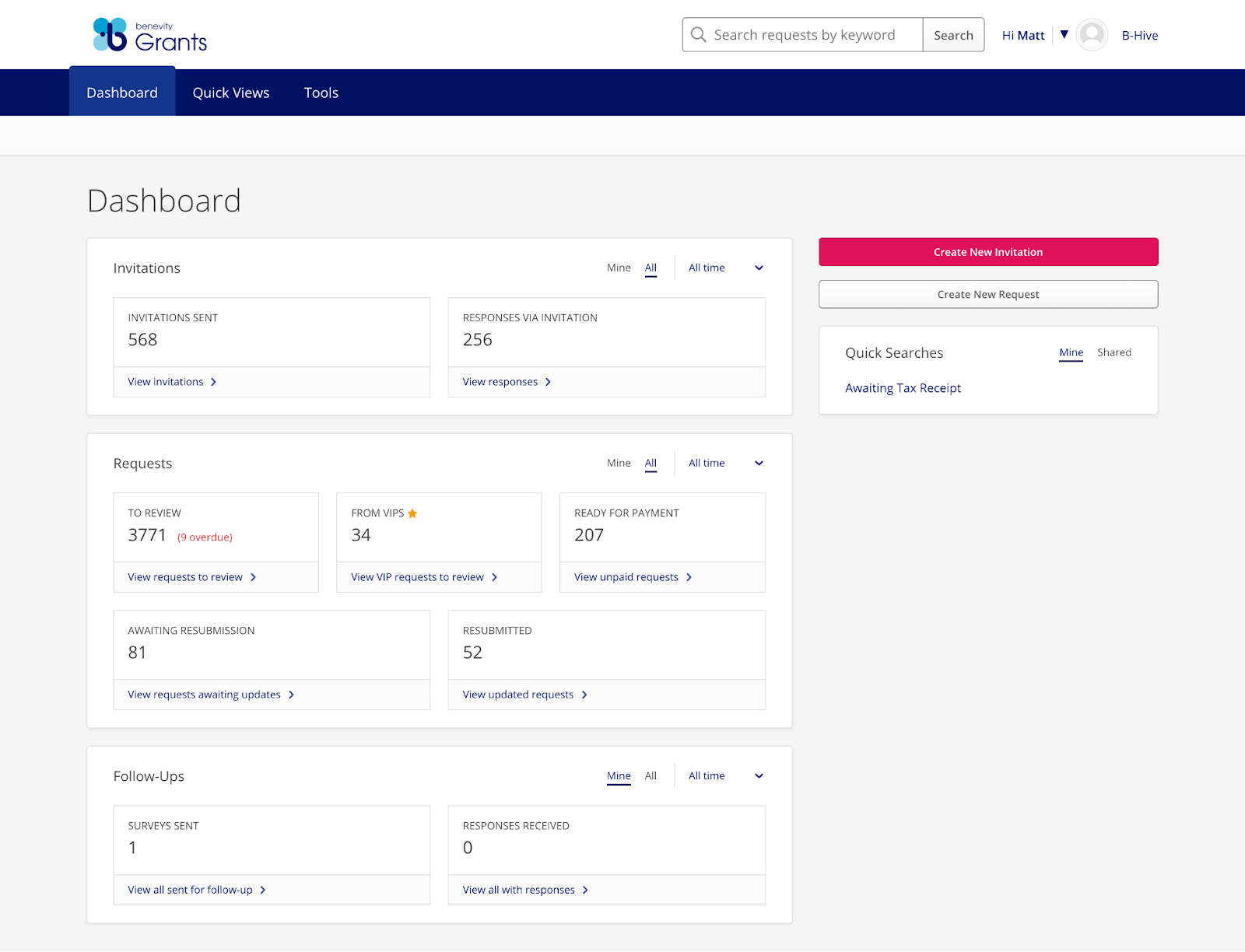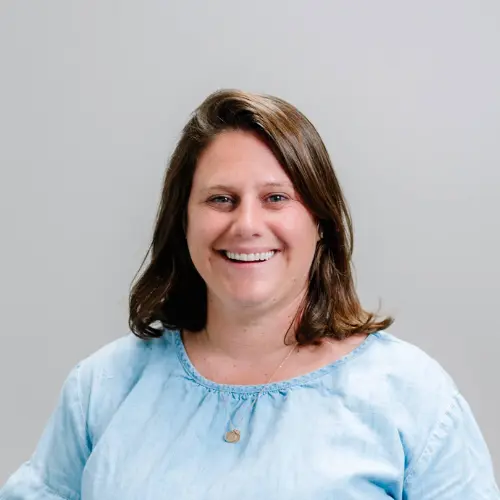Key takeaways
- Grants management software simplifies complex workflows to help corporate social responsibility (CSR) and grantmaking teams save time, reduce manual work and stay organized as programs grow.
- The right platform improves impact visibility, making it easier to demonstrate alignment between grantmaking efforts and broader business goals.
- Investing in grants management software is often driven by program complexity, stakeholder pressure and administrative overload.
- Successful adoption depends on involving stakeholders early, highlighting process gaps and framing the investment in terms of business outcomes.
- Benevity Grants Management enables strategic, scalable growth by automating tasks and improving grants data quality, so teams can focus on priorities that matter.
Today’s CSR and grantmaking teams are leading some of the most strategic and visible work in their organizations, often with very few resources.
At enterprises with 10,000 to 50,000 employees, the median CSR and grantmaking team has just four people — all responsible for delivering social and business outcomes. On top of that, 74% of organizations report that they are executing best practices in grantmaking but only 51% believe they’re doing it well.
Many teams still manage grants manually: using spreadsheets, emails and siloed systems that can’t keep pace with the growing complexity of modern grant programs. That’s where grants management software comes in.
In this guide, we’ll explore what grants management software is, why it matters and how it can help your organization build a more effective and scalable granting program. Whether you’re launching a new social impact initiative or scaling an existing one, you’ll learn how the right software can simplify grants management and amplify your impact.
Grant management software explained
So, what exactly is grants management? Grants management is the process of overseeing the full lifecycle of a grant, from identifying funding opportunities and managing applications to disbursing funds, tracking progress and reporting outcomes.
For companies with corporate giving or granting programs, it means managing grantee relationships, measuring social and business impact and ensuring compliance. The right tool can make this process a lot more efficient and impactful.
What is grants management software?
Grants management software is a digital platform that centralizes every stage of the grantmaking process — from applications and reviews to impact measurement, reporting and compliance. By consolidating information, workflows and documentation in one place, it reduces administrative burden and allows teams to focus on strategic, mission-aligned work with clearer visibility into fund allocation and use.
How do you keep track of grants?
Without a centralized system, many CSR and grantmaking teams rely on spreadsheets, email threads or disconnected tools to keep track of grants. This makes it difficult to monitor grants statuses, track deadlines and generate reports.
A modern grants management platform solves this by providing a single source of truth for your program data, from application intake to final reporting.
With the right platform, you can:
- Track applications and funding in real time
- Review and score proposals against custom criteria
- Generate detailed reports for internal and external stakeholders
- Maintain compliance with tax and regulatory requirements
- Streamline funds disbursement with secure payment processing
- Leverage reporting and survey data to help tell a story of impact
These capabilities allow teams to stay organized, scale with confidence and focus more on impact, not admin.
Key benefits of grants management software
Grants management software helps CSR and grantmaking teams do more with less, especially as programs grow in size and complexity. By automating manual tasks and centralizing data, these platforms allow teams to focus on strategic work that drives impact.
Some of the most valuable benefits include:
- Save time and reduce manual work: Automate repetitive tasks like grants intake processes, reviews and approvals, payment processing and report generation.
- Improve visibility and tracking: Centralize all grants data in one system, making it easier to track funding, deadlines and program performance in real time.
- Prove impact and aligning with business goals: Generate reports that clearly show how grants support both community outcomes and corporate priorities.
- Reduce risk and ensure compliance: Built-in nonprofit due diligence and compliance tools help you validate nonprofit eligibility, meet company and regulatory requirements, prepare for audits and protect your organization’s reputation.
- Enhance collaboration and stakeholder engagement: Enable smoother coordination with internal teams and external partners through centralized communication tools.
- Scale and adapt with ease: Manage more grants, nonprofits and regions — without overloading your team.
Grants management software in action: MiTek
In this interview, Clare Brewka, Manager of Global Community Engagement at MiTek, shares key insights on grants management software for social impact professionals and reflects on MiTek’s own grantmaking journey, from recognizing the need to selecting and implementing the right solution.
How to know when it's time to invest in grant management software
It’s not always obvious when your program has outgrown manual tools. But there are clear signs, both internal and external, that signal it’s time to consider a grants management solution.
Clare Brewka, suggests watching for a few common signs:
1. Stakeholder pressure is increasing
When team members, executives or customers are pushing for faster decisions or more transparency, you need the infrastructure to meet those expectations.
As Clare puts it, “If that pressure’s there [from stakeholders], it means you need to have good processes and good infrastructure in order to make that change and drive greater positive impact.”
2. You’re trying to scale without scaling your team
Whether you’re expanding globally or taking on more funding cycles, growth without additional resources can quickly become unsustainable.
“If you want to scale your program locally or globally, you might need some additional capacity to help you do that,” says Clare.
3. Administrative burden is slowing you down
When tasks like reviewing and processing grants requests become disorganized or overwhelming, it’s a strong sign that your systems aren’t keeping up.
“It seems simple, but when your administrative tasks related to a grants program, like reviewing and processing grant requests, becomes overwhelming or disorganized, that can be a really significant red flag," she points out.
4. Your program’s complexity is increasing
It’s not just about volume. If you’re moving toward relationship-based or impact-driven grantmaking, even with a smaller number of grantees, that depth can demand more structure.
Clare noted that even with a small number of nonprofit partners, MiTek needed software to adequately support them, stating that by implementing grants management software, they were able to take the time they needed to onboard a select number of causes with a refreshed understanding of their grantmaking process.
How to get buy-in for investing in grant management software
Getting stakeholder support for grants management software is about more than just choosing the right tool; it’s about demonstrating its value across your organization. Clare explained how her team approached it with intention and inclusivity and shared some practical tips to help you secure buy-in.
1. Map your key stakeholders early
“Identifying your stakeholders and defining what their level of anticipated investment is going to be is pivotal,” says Clare. Determine who needs to be involved in the decision-making process, like board members, senior leaders, legal, finance, communications and IT. Then, define each group’s role and stake in investment, implementation and rollout.
2. Make the case with real gaps and needs
Start by evaluating your current grantmaking processes. Are they time-consuming, disorganized or missing key compliance checks? Are you capturing the necessary information needed to measure and report impact? Clare’s team documented these pain points to show where software could add immediate value.
3. Build a collaborative process
Don’t just inform stakeholders: involve them. MiTek’s team invited cross-functional partners to review RFPs, attend demos and give feedback on each platform. For Clare’s team, inviting all stakeholders to the table “was one of the pivotal elements of getting their feedback and buy-in” and allowed them to run a truly inclusive process.
Securing buy-in is easier when stakeholders see the value and feel included in the entire process. For programs with employee-driven decision-making, these employee-led granting best practices can help guide your approach.
4. Set a realistic timeline
Align the implementation schedule with other priorities, and give stakeholders a clear sense of what’s required and when. Planning ahead prevents competing initiatives from stalling progress.
5. Connect to business outcomes
Frame the investment in terms that matter to leadership, like improved efficiency, reduced risk, better reporting and strategic alignment. Employees who are highly engaged in both giving and volunteering are 57% less likely to leave their job, making purpose-driven programs a powerful retention lever. Tying your case to measurable value helps secure long-term support.
How to demonstrate ROI from grant management software
Investing in new software always comes with scrutiny, especially when budgets are tight. Demonstrating the return on investment (ROI) of grants management software means showing both tangible and strategic value: saved time, better data, reduced risk and stronger alignment with business goals.
Here are a few factors to point out to help make the case and prove impact:
- Time and cost savings: Track time saved through workflow automation, like fewer emails, reduced manual reporting and streamlined approvals.
- Stronger compliance and reduced risk: Highlight how automated due diligence and audit trails reduce the likelihood of errors or noncompliance.
- Improved reporting and transparency: Share real-time dashboards and outcome data with executives, board members or partners. Clear grants metrics help reinforce the value of your grantmaking efforts and the system behind them.
- Greater alignment with your organization’s priorities: 88% of leaders feel their impact strategies are helping to future-proof their business. Use grants data to show how programs support key business objectives like talent retention, brand reputation or community investment.
When software empowers your team to work smarter, scale faster and show impact, it becomes a catalyst for lasting change.
Getting started with grants management software
If your team is ready to implement grants management software, a thoughtful, values-aligned approach can make all the difference.
Before you begin, take time to clarify your program’s purpose and funding criteria. Determine what success looks like, both internally and externally, so that you empower your teams with a solid foundation.
Set yourself up for success by:
- Starting with strategy: Make sure you understand what you’re funding, why and how you’ll measure success. Without clear criteria, software can’t automate or optimize much.
- Being realistic about capacity: Even small companies can use grants management tools, but it helps to know what level of lift your team can support. Implementation and onboarding require time and cross-functional input.
- Choosing progress over perfection: You don’t need every answer before you get started. Look for a platform that can grow with your program and adjust as your needs evolve.
- Going slow to go fast: Taking time to onboard thoughtfully will pay off later. Clare’s team started with a small group of long-time partners before scaling to new nonprofit relationships. “Choose grants management software when you know you have the capacity and desire to really commit to social impact with a measurable lens,” she advises.
Features to look for in grant management software
Your grants management platform should reflect the same intention and integrity as your social impact program. Whether you’re running a global corporate program or a smaller, local initiative, here are some essential features to look for.

Corporate giving expertise: Look for vendors who specialize in working with corporate funders. Some platforms are built for private or family foundations, but corporate grantmaking comes with its own unique complexities.
Global capabilities: If you’re funding causes across borders, you need a partner that understands international giving. That includes support for multiple languages and currencies, plus built-in nonprofit due diligence tools to assess risk and ensure compliance.
Built-in due diligence: Strong platforms help you give to nonprofits who have been properly verified, validated and vetted to ensure utmost compliance and help mitigate risk for your organization.
Configurable workflows: Every organization’s impact program is different, so avoid cookie-cutter solutions. Look for a platform that adapts to your grants criteria, review process and reporting needs.
Support for inclusive and equitable grantmaking: Language capabilities and accessible design help ensure that nonprofits everywhere can engage fully with your program: a priority for many companies focused on equity.
Transparent pricing: Ensure the pricing model matches your needs, and factor in growth. MiTek emphasized the importance of stewardship and finding a partner whose value aligned with their long-term investment.
Simplify grants management with Benevity
Choosing the right grants management software can unlock a new ability to align your program with business goals and deliver lasting value for your organization, partners and communities you serve.
Benevity Grants Management supports organizations through every stage of the grantmaking process — helping teams reduce manual work, strengthen partnerships and scale impact. By combining automation, scalability and purpose-driven expertise, Benevity helps reduce manual workflows and amplify impact through:
- Multilayer nonprofit due diligence: Gain confidence that every grantee is validated and vetted. Our team understands complex global regulations to protect your brand and strengthen your credibility.
- Reliable disbursement process: Guarantee that grants reach nonprofits quickly and in local currencies — reducing friction, increasing transparency and maximizing every dollar’s impact.
- Nonprofit partnership support: Empower your grantees to thrive through better collaboration, reduced administrative burden and stronger relationships.
Discover what’s possible with the right platform
Motorola Solutions Foundation offers another example of what’s possible with a grants management platform that delivers trust, scale and insight.
After 17 years with a legacy provider, Motorola Solutions transitioned to Benevity to meet growing needs — without disrupting their impact. By centralizing processes and improving data quality, the team was able to shift focus from administration to strategy.
After switching to Benevity, they saw:
- More qualified applicants: The number of organizations who started the application process increased by 40%, leading to an increase in grant applications and greater efficiency.
- Stronger proposals, less admin: A new eligibility quiz cut unqualified submissions by 43%, helping the team focus on high-potential applications.
- Better reporting, greater impact: Automated reports now save the team dozens of hours each year, enabling them to reinvest their time where it matters, like better storytelling and data-driven decision-making.
“It was the patience, thoughtful and methodical approach of our Benevity Sales and Implementation teams that helped us realize that a successful transition was not only possible; it was necessary for us to continue to grow and drive the impact that we wanted.”
Ready to evolve your grant program with smarter tools and stronger results? Benevity is ready to help.









